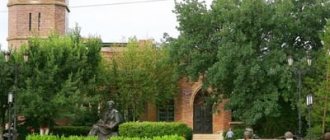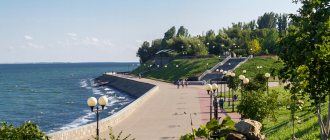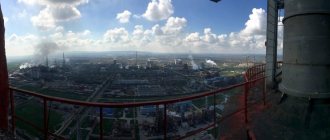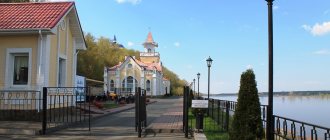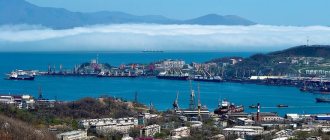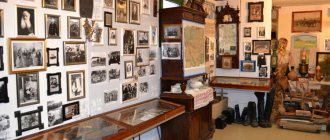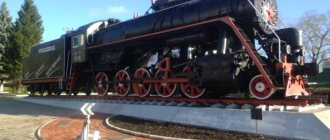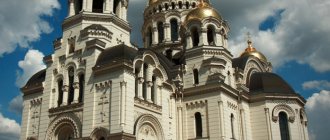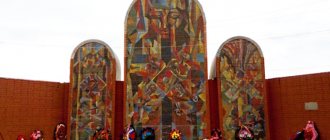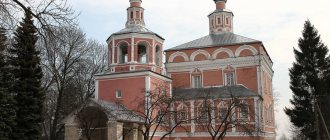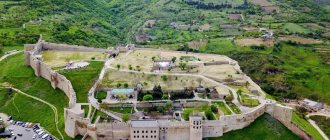I will continue the story about our journey through the Kostroma and Vologda regions along the old Arkhangelsk route from Moscow to Totma. Having said goodbye to Kostroma and Sudislavl, we went to Galich. Galich is an incredibly beautiful city in the Kostroma region, lying on the shores of the picturesque Galich Lake. Unfortunately, during the few hours that I spent there, I was not able to feel its spirit. Perhaps because we never climbed Mount Balchug (Shemyakin Hill), where the ancient settlement is located, or we walked too little around the city, preferring to visit the Museum of Local Lore. Be that as it may, I will definitely return to Galich again.
Upper shopping arcades in Galich
Epiphany Church
It is believed that this church, located in the center of the city, is the earliest surviving building in Galich. First mentioned in 1635. It was built in 1710 instead of a wooden church.
At the same time, a tent-type bell tower was built. Ten years later, a new church with the same name was built nearby, which had no heating. According to evidence from the late 19th and early 20th centuries, a monastery that has not survived existed for some time on the territory of the temple.
Location: Podbelskogo street.
Galich temples and churches
Religious buildings in Galich are among the oldest in the entire Kostroma region. Not all of them have survived in their original form, but even the converted buildings are of great historical value.
Spaso-Preobrazhensky and Annunciation Cathedrals
- Address: st. Svobody, 12a.
The winter Church of the Transfiguration of the Lord is part of a temple complex with the nearby summer Church of the Annunciation. Both buildings appeared in the 18th century with the assistance of Empress Catherine the Great. The temples, like siblings, shared all the joys and sorrows and were united by a common bell tower.
In the 1930s, the wonderful cathedrals were beheaded, stripped of their exterior and interior decor, and given to a bakery. The bell tower was destroyed to the ground. The former religious buildings stand out among the factory buildings thanks to the stone window frames and the protruding altar.
Recently, a marble plaque was hung on the wall of the Annunciation Cathedral in memory of the visit of Emperor Alexander I in October 1824. The monarch was passing through the city and on the Feast of the Intercession of the Most Holy Theotokos visited the Church of the Annunciation.
Church of St. Cosmas and Damian
- Address: Gora Revolyutsii street.
On the outskirts of the city on Kosmodemyanskaya Hill there is a white church of the 15th century, consecrated in honor of the holy martyrs Cosmas and Damian. The structure was erected at the expense of the local boyar Ivan Ovin; initially the temple was the center of the monastery of the same name.
Later, the street on which the monastery stood was named Ovinova Sloboda in honor of the benefactor. At the beginning of the 18th century, the monastery ceased to exist, and the Cosmo-Damianovskaya Church turned into an ordinary parish.
In the middle of the century, a new stone structure was erected on the site of a building that had dilapidated over three centuries; local merchant Iakinf Skornyashnikov donated money for the construction. Half a century later, the temple was rebuilt again and decorated with fresh paintings. The most serious trials came in the 20th century. In 1940 the church was closed. Despite the intercession of the Galician believers, the building was looted and partially destroyed.
The Soviet government tried by all means to erase traces of Galich's Orthodox past. The bans affected not only churches, even old names associated with religion were destroyed: Ovinova Sloboda turned into Zheleznodorozhnaya Street, and Kosmodemyanskaya Mountain was renamed into Revolution Mountain.
After the war, local residents again asked the administration to open the temple, but few of them lived to see the joyful event: the church was returned to the Orthodox only in 1990. Today the temple has been restored and is operational.
Vvedensky Temple
- Address: Sverdlova street.
The Vvedensky Church in Rybnaya Sloboda takes the place of the Vasilyevsky Monastery, founded in the first half of the 17th century. Almost nothing is known about the monastery; history has left little information about the life of the monastery, but it has preserved two wonderful churches. The stone Church of the Entry of the Blessed Virgin Mary into the Temple was erected much later - in 1798.
The large building housed three chapels: the central Vvedensky chapel, the chapel in honor of St. Kirill Novoyezersky and the chapel in honor of St. Seraphim of Sarov.
Half a century later, a two-story porch was added to the western side of the cathedral, and a few years later a parish school began operating at the church. In the 30s of the 20th century, the church was closed and mercilessly redrawn. In the 70s, the building, in terrible condition, was handed over to the Church and gradually restored. Now services are held again in the snow-white five-domed church.
Church of St. Basil the Great
- Address: st. Sverdlova, 20.
The summer Church of St. Basil, together with the winter Church of the Vvedensky, forms a single temple complex. The spacious five-domed temple was built in the Baroque style. During Soviet times, the temple was abandoned and began to collapse.
The church lost its domes and crosses, and the bell tower lost its upper tiers. In the 90s, the building began to be restored, but complex restoration work requires considerable expenses and progresses very slowly. Divine services are held in the neighboring Vvedensky Church.
City station
At the beginning of the last century, Galich became an important railway junction of the Northern Railway. In 1905, the first train arrived at the local station. Initially, the station building was built of wood in the Art Nouveau style characteristic of that time. It served for decades.
In 2009, on the eve of its 850th anniversary, a modern brick building was inaugurated in the city. All conditions for high-quality passenger service have been created here: there are railway and bus ticket offices, public catering outlets, and auxiliary premises.
Galich settlements
On the territory of the city there are ancient settlements that served as the basis for its emergence. The lower settlement dates back to the 12th century and is located on a hill called Balchug. Above it on Shemyakina Mountain there is an upper settlement dating back to the first half of the 16th century. Both fortifications are connected by a staircase.
There is an observation deck at the top. It offers a panoramic view of Lake Galich and views of the city ramparts and defensive ditches. At the edge of the observation deck, a large cross was erected in memory of the city’s defenders during the Time of Troubles.
City Park
In connection with the celebrations on the occasion of the 300th anniversary of the House of Romanov in Galich in the spring of 1913, the city garden was inaugurated. This place quickly became popular for family walks and recreation for city residents.
At the same time as the garden was being laid out, the old defensive city ramparts, which were a landmark of the city, were being improved. Staircases were built here, trees and ornamental bushes were planted. Until the middle of the last century, the appearance of the garden did not change, then it was neglected. Work is underway to restore its original appearance.
Museum of Local Lore
It was created in 1922 through the efforts of local historians. Here are collected unique rarities that reveal the peculiarities of local traditions and life. Among the 15 thousand exhibits is a rich collection of kitchen utensils and dishes, ceramics, sculptures and other wood products.
Particularly noteworthy is the wonderful collection of clothing from past centuries and paintings woven by handicraftswomen. Works by local artists, many documents and photographs are presented. The Galich Museum is part of the Kostroma Historical and Architectural Museum-Reserve.
Location: Lunacharsky street - 11.
Nikolaevsky Starotorzhsky Monastery
Built in the Middle Ages, the St. Nicholas Starotorzhsky Monastery is located next to the ancient settlement that gave rise to the city. Today it is a unique stone complex, the center of which was considered the largest Trinity Cathedral in the Kostroma province.
The five-domed, four-footed temple is an example of late classicism. It preserves unique frescoes. The cathedral, which is currently closed, requires restoration work.
Location: Lunacharsky street - 59.
Monasteries of Galich and surrounding areas
In different eras, several monasteries and convents were founded on Galician soil. Some monasteries suffered a common fate: over time, monastic life in them died out or came under ban, and monastery churches became parish churches. Nevertheless, some of the ancient monasteries were restored.
Nikolaevsky Starotorzhsky Monastery
- Address: Lunacharsky street.
The ancient monastery was founded on the shores of Lake Galich. In 1668 the monastery was reformed into a women's monastery. The center of the monastery is the delightful five-domed Trinity Cathedral, which in its grandeur and sophistication of forms is not inferior to the best churches in St. Petersburg.
The magnificent building in the style of late classicism is considered the largest religious building in the entire Kostroma region. Inside you can see ancient frescoes, partially erased by time and vandals.
The building became one of the later buildings on the territory of the monastery. Construction of the temple began in 1838 and was consecrated 20 years later. The cathedral was closed in 1936 and remains unrestored.
Assumption Paisievo-Galich Monastery
- Address: Uspenskaya st., 11.
The convent on the outskirts of Galich is the oldest of all those preserved in the Kostroma region. The monastery was founded in the 14th century in the Uspenskaya Sloboda, which is currently part of the city district. According to the chronicles, the monastery was originally called Nikolsky.
According to legend, the monastery was founded by a young monk, who later became famous as St. Paisius of Galich. The saint lived in the monastery for 70 years in labors and prayers, and for his pious life he was elevated to the rank of abbot, and then to the rank of archimandrite.
Even during the life of the saint, an icon of the Mother of God miraculously appeared to boyar Ivan Ovin, who wanted to build a temple in the monastery. The boyar built a new church, which was consecrated in honor of the Dormition of the Blessed Virgin Mary. The new stone Assumption Church was built in the 17th century in the Old Russian style and has survived to this day. The refectory part was crowned with five domes, and a bell tower adjoined the building on the western side.
The monastery became one of the first victims of the atheistic policy of the Bolsheviks: the monastery was closed in 1919, the brethren were dispersed. Some of the buildings were destroyed to the ground, the rest began to be used for the needs of the working people. Monastic life began to revive in 1994. At the moment, the cathedral has been restored, and the area around it has been improved.
Avraamiev Zaozersky Monastery
- Address: Galich district, Umilene village.
The monastery on the other side of Lake Galich in the village of Umilenie was also founded in the 14th century. The founder of the monastery was the Monk Abraham of Chukhloma. It is believed that an icon of the Mother of God appeared to the saint at this place. Abraham built a wooden church of the Assumption of the Blessed Virgin Mary, which was replaced with a stone one in the 18th century. At the end of the 19th century, the architectural ensemble was complemented by a bell tower.
In the central cathedral there were three chapels: the Assumption, the “Sign” icon, the “Tenderness” icon, etc. Abraham Chukhlomsky (Gorodetsky). Next to the huge five-domed structure, the small church of the Holy Apostles Peter and Paul modestly stood. Residents of eight surrounding villages came to the monastery churches to pray.
The Soviet government treated the monastery cruelly. The monks were kicked out of the monastery, and the churches were beheaded, the roofs collapsing. For many years, the once beautiful buildings were abandoned, empty windows gaping in the bare brick walls.
Several years ago the monastery began to be restored. First of all, the roofs of the temples were repaired and crowned with beautiful blue domes with golden stars. The Peter and Paul Church, due to its small size, was restored before other buildings. Today, spiritual life in the village is gradually being revived, just like the ancient monastery.
Galich Lake
The city is located on the shores of Lake Galich, which is one of the largest similar reservoirs in Russia. Its banks represent a picturesque, calm landscape created by gentle hills, thickets of bushes and reeds. The lake stretches for 17 kilometers and is 6 kilometers wide. Several rivers flow into it, and there are many springs here. The depth does not exceed two meters. This is a wonderful place to relax and has a lot of fish.
History of Galich under Prince Dmitry Shemyak
Dmitry Yuryevich Shemyaka (beginning of the 15th century - 1453) - Grand Duke of Moscow, as well as Prince of Uglich and Galitsky; son of the Grand Duke of Moscow Yuri Dmitrievich and Princess Anastasia Yuryevna, daughter of the last Grand Duke of Smolensk Yuri Svyatoslavich, one of the main participants in the internecine war of the second quarter of the 15th century.
It is not uninteresting that in 1445 the Galician prince Dmitry Shemyaka was able to capture Moscow, but was never able to gain a foothold there. His detachment was defeated by the superior forces of Vasily II (later Vasily II received the nickname Dark), whom Shemyaka had recently deprived of his sight with his own hands.
In 1450, the troops of Vasily II approached the city of Galich, but they were unable to take it by storm.
By the way, Prince Dmitry Shemyaka was the first in the history of Russia to use cannons and arquebuses in the defense of the fortress. And although no one was harmed by them during the siege, these weapons inspired incredible horror on the Moscow warriors.
In the bloody struggle, Galich once again confirmed the glory of a formidable and impregnable, well-fortified and protected city, but was voluntarily surrendered to Vasily II the Dark by residents who did not like Shemyaka.
Fire Tower
In 1899, a two-story fire station building was built in Galich. The need for it was caused by the continuous wooden buildings of the settlement, in which fires periodically broke out. To constantly monitor the situation, a four-meter high tower was built on the building.
When signs of fire were detected, firefighters sounded the alarm, notifying city residents. A bright yellow wooden tower adorns the modern fire station. It is one of the symbols of the city.
Symbol of the founding of the city
On the eve of the celebration of the city's 825th anniversary, a stele was erected in its center on Revolution Square, reminiscent of the founding of the ancient city. It is made of concrete and rises more than ten meters. The structure is crowned with a sculptural image of an ancient Russian sailing ship. This boat became a symbol of the founding of the city. The stele is also decorated with the city's coat of arms.
Monuments and memorial sites of Galich
Galich monuments can literally be counted on one hand, so it’s easy to see all the objects in one day.
Symbol of the founding of the city
- Address: Revolution Square.
The main monument of Galich decorated the central Revolution Square in 1983 on the eve of the city’s next anniversary. The symbol of the city is a narrow stone stele about 10 meters high. In the middle hangs the city's coat of arms, and at the top is a boat-ship in the ancient Russian style. The monument stands right in front of the shopping arcades and is surrounded by flower beds.
Monument to V.I. Lenin
- Address: Ledneva street.
The most common Soviet monument is also installed on the central square between the shopping rows. The main Russian revolutionary is depicted in full height, the leader of the proletariat looking thoughtfully over the horizon, into the bright communist future of the country.
Some Galicians want to demolish the monument, but it still remains in its place. Such statues are becoming rare in the Kostroma region: in the 90s of the last century, out of 30 Ilyichs, only 8 survived.
Monument to a crane
- Address: st. Gladysheva, 27.
An interesting sculpture in the form of a crane rises near the crane equipment plant. It is at this plant that truck cranes with the inscription “Galician” are produced, which can be seen in almost every locality in Russia. A smaller copy of a crane on a high column pedestal is at the same time a monument to construction technology and a symbol of the enterprise.
Monument to the tractor DT-54
- Address: st. Gladysheva, 71.
A real crawler tractor stands proudly on a brick pedestal near the Galich Industrial College. The black plaque under DT-54 states that the monument was erected in 1990 in honor of the 75th anniversary of the educational institution. The tractor was used in agriculture mainly in the 50-70s; during all this time, Soviet factories produced about a million units of equipment.
See reviews of interesting places in other cities of the Kostroma region - Nerekhta and Kostroma
Galich is undeservedly ignored by tourists and pilgrims. This small town in the Kostroma region contains many Orthodox shrines and, like a puzzle, is made up of buildings from different eras. He will definitely find something to surprise even travelers who are satiated with impressions.
Square in honor of the Victory
Not far from the shopping arcades in the city center, a small park was built in honor of the Victory in the Great Patriotic War. It contains a monument to hundreds of Galicians who went to the front and did not return home.
The monument is a tall stele with the dates of the beginning and end of the war. Nearby is a figure of a Soviet soldier mounted on a rectangular pedestal. City residents bring fresh flowers here. War veterans are honored here and memorial events are held.
A brief history of the city of Galich, Kostroma region.
In 1246, the city of Galich became the capital city of the independent appanage Galician principality. And his first prince, Konstantin Yaroslavich (the son of the Vladimir prince Yaroslav and the brother of the Grand Duke Alexander Nevsky) became the founder of the dynasty of princes of Galicia, who ruled the principality from 1246 to 1363.
In 1363, the lands of the Principality of Galicia were annexed to the Principality of Moscow.
In 1427, the Kazan Tatars besieged Galich with a large army. For a whole month they tried to storm the city, but they could not defeat it. In 1429 they tried again and repeated the campaign against Galich, and also without success.
Shopping arcades
Evidence of the active role of Galich in the development of trade in past centuries is the trading rows that have been preserved here. These are two one-story buildings of several buildings with beautiful arched vaults, built in 1825 in the central part of the city. From here grain was supplied to Moscow, and furs were supplied abroad. Due to the fact that they were erected on a hillside, the buildings were named Upper and Lower.
Location: Podbelskogo street.
The main architectural monuments in Galich
Galich can be called an open-air museum, where the exhibits include hundreds of ancient residential buildings and municipal buildings. Walking around the city, it is worth highlighting several buildings that played an important role in the lives of the townspeople.
Fire Tower
- Address: Porechye street.
The fire department building in Galich presents a curious sight: in the middle of the city stands a simple, light-colored two-story building with a bright orange multifaceted tower protruding from the roof.
The four-meter fire tower is one of the most unusual buildings in the city; its interesting shape and round observation deck make it look like a lighthouse. The fire station was built at the end of the 19th century. In those days, almost all buildings were wooden, and devastating fires often occurred in the city. The fire station is still in operation.
Shopping arcades
- Address: st. Revolution Square, 29.
Trading arcades are one-story buildings typical of ancient Russian cities, in which merchant shops were located centuries ago and active trade took place. Galich buildings are located at different heights on the slope of a small hill, which is why they are nicknamed Upper and Lower.
The buildings were built in 1825 in a classical style, their facades are decorated with rows of strong columns, arches and porticoes. The beautiful rows, which have become one of the symbols of the city, are maintained in good condition.
Men's gymnasium
- Address: st. Dolmatova, 13.
The beautiful gymnasium building was erected in 1813. According to local legend, the educational institution was built by captured French soldiers and officers who did not have time to escape from Russia a year earlier during World War II. The two-story brick structure in a classical style resembles some neighboring houses; according to one version, it was originally a residential building, but then became the property of the local administration. At one time there was a prison here, then the building stood abandoned for about 20 years and only in 1909 it became an educational center.
Over the next eight years, the gymnasium was repaired, rebuilt and supplemented with extensions more than once. On the eve of the revolution, more than 200 children studied at the institution. There were 14 classrooms inside: one was reserved for physics classes, another was for art history lessons, the third was for natural sciences and history, the fourth was for textbooks, 2 had libraries, and the remaining 8 belonged to classrooms. Concerts, meetings and gymnastics classes were held in the annexes.
After 1917, the men's gymnasium was transformed into a second-level school. In the 20s, the famous physicist B.P. studied there. Konstantinov. In 1931, the educational institution began to be called Galich School No. 1. In 2005, the building received the status of a cultural heritage site, and in 2008 the school was again converted into a gymnasium. Today, the architectural monument is in good condition and continues to serve the cause of public education.
Hotel I.I. Gromova
- Address: Svobody Street, 2.
The three-story hotel building in the historical part of the city was for a long time the largest in all of Galich. The house belonged to the family of wealthy businessmen, the Gromovs, who traded in textiles and owned a distillery. On the ground floor of the hotel, enterprising owners opened a tavern and several retail shops.
In October 1917, the Galich Bolsheviks were waiting here for news from Petrograd and, having learned about the coup, convened a meeting of the cell. After reading the telegram from the capital, representatives of the losing side transferred power to the communists, who immediately elected a revolutionary committee.
About 20 years later, a Soviet party school began operating in the former hotel, then, during the Great Patriotic War, a hospital was located in it. After the victory, a school for collective farm personnel was opened here, which 8 years later was reformed into an agricultural technical school. By 2010, the building underwent a major renovation.
Rybnaya Sloboda
- Address: Gladysheva street, 9A.
Galich has long been famous for fishing; trade in gifts from Lake Galich continues to flourish in the city. Centuries ago, on the coast of the reservoir, fishermen founded a settlement, which they called Rybnaya. Many houses have survived to this day. The cozy streets of the settlement contain many wooden architectural monuments; almost all the buildings remain residential.
